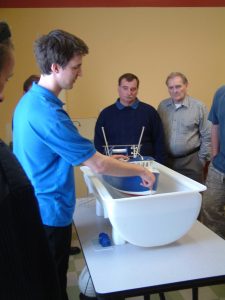Advanced and Skippers Ticket Course Details
Seafish Stability for Experienced fishermen
One day course, cost £140 (Discounted to £120 if paid in advance) Funding currently available for commercial fishermen who have completed all the mandatory courses
This course is one of those required for applying for the Seafish Under 16.5m Skippers Ticket
By the end of the Stability Awareness for Experienced Fishermen course participants will understand:
1. The extent of the effects of poor vessel stability to deaths in the fishing industry
2. Stability hazards, risk and the risk equation
3. How to mitigate against risk and the risk spectrum
4. The forces that affect the stability of fishing vessels
5. Stability and the terms used to describe vessel stability
6. How external forces, the transverse movement of weight, the FSE and the up-ward movement of weights form stability hazards
7. How the principles of stability apply to deck and below deck operations
8. How to minimise the risks associated with deck and below deck operations
9. How vessel watertight and weathertight integrity is maintained
10. How to monitor vessel stability using the Wolfson Guidance Mark
11. The stability implications of alternative deck procedures

Seafish Advanced Stability
One day course, cost £140 (Discounted to £120 if paid in advance) Funding currently available for commercial fishermen who have completed all the mandatory courses
This course is the more advanced course available to anyone who has already completed the Seafish Stability for experienced fishermen course and is a requirement for anyone applying for the Unrestricted Seafish Under 16.5m Skipper’s ticket for the first time
By the end of the Advanced Stability Awareness course participants will understand:
1. How poor vessel stability links to deaths in the fishing industry
2. Risk, the ALARP principal, ‘Event and Consequence’ and the Risk Spectrum
3. The responsibilities of the skipper in respect to managing stability risks
4. Event chains using event and consequence diagrams
5. How weight and the shape of a vessel contributes to vessel stability
6. The stability of both ballast stable and form stable boats
7. Initial (GM) and static stability (GZ)
8. The methods used to monitor risks to stability
9. The risks posed by external forces, the transverse movement of weight, the FSE and the up-ward movement of weights and the condition of a vessel are managed
10. How vessel watertight and weathertight integrity is managed to minimise risk
11. How vessel condition and modifications are managed to maintain stability
12. How to monitor and maintain the stability of a vessel during fishing operations
13. How fishing vessel stability books manage the stability risk on fishing vessels
14. The role of regulation and the regulatory organisations concerned with fishing vessel stability
Seafish 2 day Bridge Watchkeeping (Navigation) Courses
Cost £280 (discounted to £240 if paid in advance) Funding currently available for commercial fishermen who have completed all the mandatory courses
The 2 day course is one of those required for applying for the Seafish Under 16.5m Skipper’s Ticket (restricted)
On successful completion of the 2-day candidates will:
1. Understand the basic principles of watchkeeping
2. Understand the principles of safe navigation through the effective application of the collision regulations
3. Be able to obtain and interpret information that is essential to safe navigation
Seafish 5 day Bridge Watchkeeping (Navigation) Courses
Cost £700 (Discounted to £600 if paid in advance) Funding currently available for commercial fishermen who have completed all the mandatory courses
The 5 day course is one of those required for applying for the Seafish Under 16.5m Skipper’s Ticket (Unrestricted)
On successful completion of the 5-day course candidates will:
1. Understand the basic principles of watchkeeping
2. Understand the principles of safe navigation through the effective application of the collision regulations
3. Be able to complete basic chartwork to support vessel operations
4. Be able to obtain and interpret information that is essential to safe navigation
Seafish 2 day Engine Course
Cost £280 (discounted to £240 if paid in advance) Funding currently available for commercial fishermen who have completed all the mandatory courses
The 2 day course is one of those required for applying for the Seafish Under 16.5m Skipper’s Ticket (restricted)
The course objectives are by the end of the course participants will:
1. Know how an internal combustion engine works
2. Know how diesel engine ancillary systems work
3. Know how the power generated is used to propel a vessel
4. Know how to maintain safe operation of a vessel’s engineering systems
5. Know the purpose of the vessel environmental, service and pumping systems
6. Know how to carry out routine and planned vessel maintenance procedures
7. Know the types of engine and ancillary system faults that may develop
MCA Approved Engine Course (AEC)
The course is usually delivered over 4 or 5 days. Price on application.
This course is one of those required for anyone applying for the unrestricted Seafish Under 16.5m Skipper’s ticket
The course will provide training in the following areas
- The compression ignition engine
- Cycle of operation and constructional details
- The fuel system
- The role of air in the combustion process
- The cooling system
- The lubrication system
- Power transmission
- Hull fittings
- Fault finding and rectification
Short Range Certificate (Radio) (RYA)
Cost £200, including RYA registration, test and certification fee
The course is one of those required for the Seafish Under 16.5 m Skipper’s ticket
Course topics include:
- the basics of radio operation
- the correct frequencies (channels) to be used
- distress, emergency and medical assistance procedures
- making ship to shore communication
- Digital Selective Calling (DSC) using simulators
- Global Maritime Distress and Safety System (GMDSS)
- Emergency Position Indicating Radio Beacons (EPIRB)
- Search and Rescue (SART)
